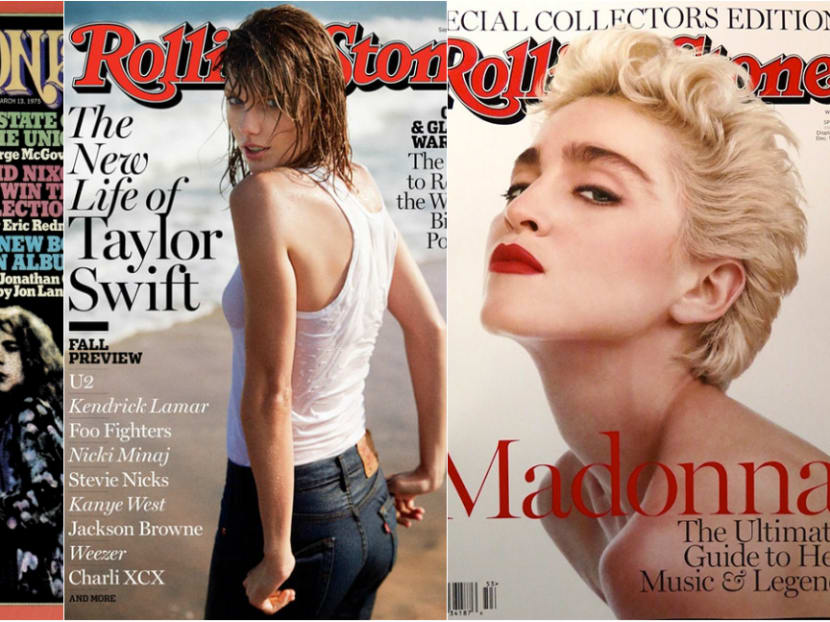Iconic music magazine Rolling Stone looks for buyer
NEW YORK — Rolling Stone, the iconic 50-year-old magazine of music and counterculture, is putting itself up for sale amid an increasingly uncertain outlook, its founder said.

Rolling Stone last year sold a 49% stake to a Singaporean music and technology start-up, BandLab Technologies, which is headed by Kuok Meng Ru.
NEW YORK — Rolling Stone, the iconic 50-year-old magazine of music and counterculture, is putting itself up for sale amid an increasingly uncertain outlook, its founder said.
Jann Wenner — who started Rolling Stone in 1967 as a hippie student in Berkeley, California and now runs it with his son Gus — told The New York Times that the future looked tough for a family-run publisher.
“There’s a level of ambition that we can’t achieve alone,” Gus Wenner told the newspaper in an interview published late Sunday (Sept 17).
“So we are being proactive and want to get ahead of the curve,” he said.
One of the most influential magazines covering rock music, Rolling Stone has also been a home for experimental writers such as the gonzo journalist Hunter S. Thompson.
But the magazine’s reputation — and finances — were badly damaged when it retracted a 2014 story about an alleged gang rape at the University of Virginia, with a review finding that Rolling Stone did not undertake basic journalistic procedures to verify the facts.
Rolling Stone last year sold a 49 per cent stake to a Singaporean music and technology start-up, BandLab Technologies, which is headed by Kuok Meng Ru, the scion of one of Asia’s richest families.
It was not immediately known if Kuok would want to take a controling stake in Rolling Stone.
The Wenner family earlier this year sold its other two titles — celebrity magazine US Weekly and lifestyle monthly Men’s Journal — to American Media, a publisher of supermarket tabloids including The National Enquirer.
If American Media, were interested in Rolling Stone, it would mark a sharp change in owners’ ideologies.
The tabloid empire is led by David Pecker, an ardent ally of President Donald Trump, while Rolling Stone tilts strongly to the left and has featured lengthy interviews with Democratic presidents Barack Obama and Bill Clinton.
Jann Wenner, 71, who is also a key force behind the Rock and Roll Hall of Fame, said that he hoped to keep an editorial role at Rolling Stone but that the decision would be up to its new owner.
Rolling Stone helped define the counterculture epoch. It filled its pages with the words of renowned writers, including Hunter S. Thompson, Tom Wolfe, Cameron Crowe and Greil Marcus. Its covers minted stars. And while it focused on music, its influence ultimately stretched into pop culture, entertainment and politics.
“It was a magazine about music and the attitudes and things that music embraced,” said Jann Wenner. “Rolling Stone has been one of the great magazines of our time.”
John Lennon appeared on the cover of the magazine’s first issue, followed by nearly every rock star, and many celebrities, from the 1960s onward. Wenner was a particular fan of Bob Dylan, who has appeared on the cover nearly two dozen times.
Provocative photography was also one of the magazine’s hallmarks. The celebrity photographer Annie Leibovitz began her association with the magazine in the early 1970s and set the tone for whimsical and insightful portraits, like her 1981 cover photo of Meryl Streep.
Celebrity access — to rock stars and political giants alike — was one of Rolling Stone’s greatest assets. Wenner himself conducted some of the magazine’s biggest interviews, including with Barack Obama, as a candidate and later as a president. “The access you get everywhere is phenomenal,” Wenner said.
Wenner and his editors have long been criticised for relying too heavily on ageing rock heroes for Rolling Stone’s covers. But the magazine still had the power to shock, as it did with a 2006 cover story on Kanye West that pictured him bloodied by a crown of thorns.
“For every cover of Mick Jagger, you get a cover of Taylor Swift,” Wenner said. “It’s all great music, and they all belong in one place.”
But Rolling Stone’s covers have also provoked outrage. When it featured Dzhokhar Tsarnaev, then a 19-year-old suspect in the Boston Marathon bombings, on its cover in 2013, some critics accused the magazine of glamorising him as it did entertainment superstars.
Long respected for its journalism, Rolling Stone was badly bruised by a 2014 article about an unproven gang rape at the University of Virginia. The debunked article, which was retracted in 2015 after a damning report from the Columbia Graduate School of Journalism, prompted three lawsuits and waves of negative coverage for the magazine. The magazine settled two lawsuits, one of which went to trial; a judge dismissed the third last year.
Over the past several years, Wenner has been slowly ceding control of Rolling Stone and its parent company, Wenner Media, to his son, Gus. The younger Wenner, 27, has jump-started the company’s digital ambitions, and he has plans to increase the magazine’s video production capabilities. But in response to the financial downturn facing the entire industry, he has also aggressively sold off Wenner Media’s assets, including Us Weekly and Men’s Journal.
Both Jann and Gus Wenner said they hoped to stay on at Rolling Stone under a new owner, but its sale would conclude their reign.
“It’s the end of an era,” Gus said in an interview in his office last week, “but it’s the beginning of a new, totally exciting era.” AGENCIES





